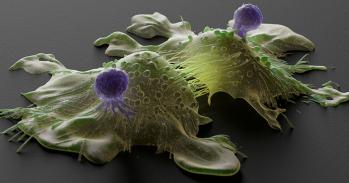
Cambridge scientists have honed techniques originally developed to spot distant galaxies and used them to identify biomarkers that signal a cancer’s aggressiveness.
Cambridge scientists have honed techniques originally developed to spot distant galaxies and used them to identify biomarkers that signal a cancer’s aggressiveness.
We’ve exploited the natural overlap between the techniques astronomers use to analyse deep sky images from the largest telescopes and the need to pinpoint subtle differences in the staining of tumour samples down the microscope
Raza Ali
Cambridge scientists have honed techniques originally developed to spot distant galaxies and used them to identify biomarkers that signal a cancer’s aggressiveness among some 2,000 breast tumours, in a study published in the British Journal of Cancer today, 20 February. The findings mean that the age-old practice of pathologists looking down the microscope to spot key differences in the staining of tumour samples could one day become a thing of the past.
To develop this new automated approach the researchers, from the Cancer Research UK Cambridge Institute, the Department of Oncology and the Institute of Astronomy at the University of Cambridge, adapted techniques used by astronomers to automatically pick out indistinct objects in the night sky.
They applied these to immunohistochemistry (IHC), which relies on pathologists being able to distinguish subtle differences in the staining of tumour cells down the microscope, depending on the specific proteins they express.
To road test the new approach they used it to measure the levels of three different proteins linked to more aggressive cancers, across tumour samples from more than 2,000 breast cancer patients.
They compared the accuracy of manually scoring these results, by observing the staining of the tumour samples down the microscope, versus relying on a computer to do this automatically. This showed that the new automated system was at least as accurate as the manual one, whilst at the same time being many times faster.
Study lead author Dr Raza Ali, a pathology fellow from Cancer Research UK Cambridge Institute at the University of Cambridge, said: “We’ve exploited the natural overlap between the techniques astronomers use to analyse deep sky images from the largest telescopes and the need to pinpoint subtle differences in the staining of tumour samples down the microscope.
“The results have been even better than we’d hoped, with our new automated approach performing with accuracy comparable to the time-consuming task of scoring images manually, after only relatively minor adjustments to the formula. We’re now planning a larger international study involving samples from more than 20,000 breast cancer patients to further refine our strategy.”
Senior author Professor Carlos Caldas, also from Cancer Research UK’s Cambridge Institute at the University of Cambridge, added: “Modern techniques are giving us some of the first insights into the key genes and proteins important in predicting the success or failure of different cancer treatments. But before these can be applied in the clinic, their usefulness needs to be verified in hundreds or sometimes thousands of tumour samples. Already this new automated approach means we can now analyse up to 4,000 images a day, helping streamline the process of translating these discoveries into the clinic.”
Dr Nicholas Walton, from Cambridge University’s Institute of Astronomy, said: “It’s great that our image analysis software, which was originally developed to help track down planets harbouring life outside of our Solar system, is now also being used to help improve the outlook for cancer patients, much closer to home.”
Dr Julie Sharp, senior science information manager at Cancer Research UK, said: “This unlikely collaboration between astronomers and cancer researchers is a prime example of how, by working together, scientists from different disciplines can bring about innovative new solutions for beating cancer.”
The Cancer Research UK Cambridge Institute is a major research centre which aims to take the scientific strengths of Cambridge to practical application for the benefit of cancer patients. The Institute is a unique partnership between the University of Cambridge and Cancer Research UK. It is housed in the Li Ka Shing Centre, a state-of-the-art research facility located on the Cambridge Biomedical Campus which was generously funded by Hutchison Whampoa Ltd, Cambridge University, Cancer Research UK, The Atlantic Philanthropies and a range of other donors. For more information visit www.cruk.cam.ac.uk.
Story adapted from CRUK press release.
This work is licensed under a Creative Commons Licence. If you use this content on your site please link back to this page.





